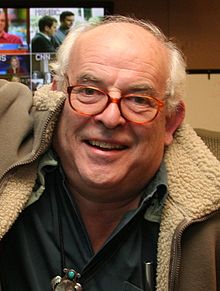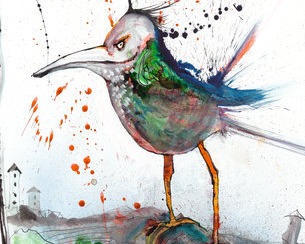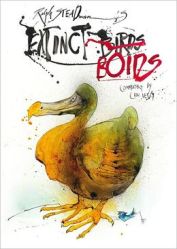 Ralph Steadman is probably best known for illustrating the gonzo journalism of Hunter S. Thompson, famous for the book Fear and Loathing in Las Vegas. Thompson is dead and gone (per his final request, his ashes were loaded into a cannon and blasted into the air outside Aspen, Colo., in 2005), but Steadman, a Brit, is still very much alive and kicking at the age of 76.
Ralph Steadman is probably best known for illustrating the gonzo journalism of Hunter S. Thompson, famous for the book Fear and Loathing in Las Vegas. Thompson is dead and gone (per his final request, his ashes were loaded into a cannon and blasted into the air outside Aspen, Colo., in 2005), but Steadman, a Brit, is still very much alive and kicking at the age of 76.
Steadman’s latest work, a collaboration with filmmaker Ceri Levy, is a coffee table book called Extinct Boids. It’s bestiary of extinct birds, some of which are real (there’s the dodo, of course, and the great auk, and many lesser-known species) and others (the Rodrigues Blue-Back Throstle and the Mechanical Botanical Spunt, to mention a few) that hatched directly from Steadman’s and Levy’s imaginations.
It’s a strange and wonderful thing — Steadman’s ink-splattered illustrations narrated by Levy’s comic journalings and notes. Think John James Audubon on a lot of acid. But there’s a serious message here, too — about how little we know about the world around us, about the damage we’ve done, and the spirit and creativity we’ll need if we’re going to save a few scraps of it for the boids and other critters.
To learn a little more about the project, I caught up with Steadman and Levy last week for an hour-long video chat that ranged from trench humor to the time Steadman got vertigo while standing over a French toilet. I’ll spare you the latter tale and a few others. Hope you enjoy the rest.
Hanscom: How are you?
Levy: I’m OK. Where Ralph has got to, I don’t —
Unidentified voice: [raucous opera singing]
Levy: Ah. I’m Ceri, and the singing part of the duo is Ralph himself.
Steadman: I should have brought my bird warbler over.
Levy: Welcome to our chaotic world, Greg.
Hanscom: Great. I’ve got both of you.
Steadman: You know what I’m doing at the moment? I was asked by a charity to design a rug — you know, like the one in front of the fire. So I’ve decided to do a bug! It’s a bug in a rug! I’m trying to make fun out of life.
Hanscom: You’ve made quite a lot of fun out of the boids. Not many people make fun out of species we’ve exterminated.
Steadman: As far as I know, nobody.

Hanscom: With this book, you’re using your drawings and stories to bring birds back to life — including birds that were never alive in the first place. What kind of message does this send to the children?
Steadman: Don’t you ever mention that to anybody. They all existed!
Levy: Ralph often says, “Who’s to say that half of these supposedly invented birds never existed?” Who knows what we’ve lost in this world that we have no idea about?
Steadman: Listen, in the last 100 years, 125 species, probably 126 [bird] species are gone now — in England alone.
Levy: There’s a certain symbolism about it: We’ve lost so much we don’t even know what we’ve lost. We’ve only got an inkling. I mean for God’s sake, they’re still finding new species all the time in various parts of the world.
Steadman: So it’s time we sent a hunting party out to shoot the buggers!
Hanscom: But has anyone objected to the way you’ve handled this subject in such a flippant, humorous way?
Levy: We did have one person say, “I don’t understand the point of such a serious subject being treated with humor,” and they got really upset about it. But isn’t that the whole thing? We all know we’re dreadful bastards. We’ve destroyed most of the world, and it’s probably unsalvageable, most of it. But instead of saying we’re all swine and we all deserve to rot in hell, you can bring people to a subject with humor and perhaps get them involved in trying to help what we’ve got left.
Hanscom: Did either of you know anything about birds when you started this project?
Steadman: Ceri contacted me, and said, “Want to do something about birds?” And I said, “Nah. Bugger off.”
Levy: So this all started because I was making a documentary. I’m a documentary filmmaker.
Steadman: Could have fooled me. I’ve never seen one of your films!
Levy: I gave you one, and you’ve never watched it! It’s in your office — in the same place I left it.
Steadman: Come over and find it for me.

Levy: I will! I know how to find things — which is probably a good thing for this project. Ever since you started working on extinction, which is about losing species, you’ve been losing things. There are actually a couple of birds in the book called the pale blue piddles —
Steadman: That drawing has disappeared.
Levy: They just went wandering.
Hanscom: The extinct birds that never existed but were brought to life by Ralph’s pen are now disappearing.
Steadman: Exactly.
Levy: We know where they are. They’ve all moved to Toadstool Island.
Steadman: That’s something I found! I found Toadstool Island. It’s right outside my studio — a mound of earth around a large dead tree. One morning, I came out and there was a lump that had come out of the ground: a perfect toadstool. I photographed it, and sure enough, it was gone the next day.
Levy: It disappeared off to the Eurilic Sea.
Steadman: Yes, but I have a urilisis, a urinal! I have one! I’ve got a circle down in the garden.
Levy: He’s not allowed to go to the toilet indoors any more.
Hanscom: [laughs]
Levy: You’re talking to some serious ornithologists today.
Hanscom: Well, I’ll give you this: Most birdwatchers that I know think of birds as representatives of a species — species that they can check off their lists. They don’t see them as individuals, characters, the way you guys have.
Steadman: Nice of you to say. I think a lot of the birds that I see in the garden now, and that includes a couple of crows that I see when I go to swim in the morning — they drop their bird lime right in my pool.
Levy: That’s because they think you’ll appreciate it!
Steadman: Right, they’re like, “Oh, obviously there’s a bird lover down there!” [Squirt!]
Levy: Ironically, I came into this because I was making — and still am making — a documentary called The Bird Effect, which is meant to be a nice, light look at the ridiculous pastime of birdwatching. I started out following birdwatchers and filming them, and before very long, I was suddenly very interested in the birds themselves.
I started thinking about how birds affect us — artists and writers and conservationists — and how they affect, influence, and inspire so many people. And it became a more cerebral journey. And I started putting together an exhibition [called “The Ghosts of Gone Birds”], approaching artists to see if I could get people to engage with the subject and come up with something.
I went to Ralph, and asked him if he was interested in birds, and he went, “No, I’ve never [drawn] them in my life.”
Steadman: Well I had. I didn’t realize I had.
Levy: Suddenly, he goes through his work, and birds have been referenced in so many pieces … It’s almost like these birds have been there in your background, Ralph, for a long, long time.
Steadman: Yeah, and I don’t know why. You know, I talk a lot about my father. He was in the first World War. He actually was in the trenches. He didn’t take his boots off for three months at a time. When he did take them off, the skin came with ’em — that was how foot rot set in. And yet, he lived on and … the thing he said, at the age of 87, is that the only thing he’d noticed about getting old was that the undertaker raised his hat to him.
They used to call that trench humor. Men in the trenches used to make up all kinds of silliness.
Hanscom: Is your book a kind of trench humor? I mean, it’s about birds that are dying out all over the world.
Steadman: Yeah. And Ceri … You know, he only asked for one [bird illustration], and I did over 100. And there’s more.
Hanscom: What was your favorite bird, Ralph — from the book?
Steadman: I think it’s the pale piddles.

Levy: They were never your favorites! It was the needless smut, surely!
Steadman: Of course, the needless smut is the best. Absolutely. The problem with the pale blue piddles is they’ve gone pissin’ missing!
Hanscom: This gives new meaning to the term “gonzo.”
Steadman: It does, really.
Levy: The needless smut was very much a key bird in the book. I just needed one image for the exhibition. But something was happening, and we were really enjoying each other’s company, and then suddenly the needless smut came along. We were talking about something on the BBC the night before, and I said, “Well there was just too much needless smut in it.” And Ralph said, “That bird needs to exist!” And by 6 o’clock, it existed.
Hanscom: How many of the birds are made up, if you’ll forgive me for asking, Ralph?
Levy: There are quite a few of them. And I’ll tell you, the Hawaiian birds Ralph came up with caused me such a nightmare. It was really hard to work out which ones Ralph did were real and which ones were not, because Hawaii — they call it the extinction capital of the world. Just before we were going to print, I was finding out, Jesus, that one doesn’t exist at all!
Steadman: Oh, the Bishop’s ‘O’o exists!
Levy: People who know nothing about birds say, “This is ridiculous — a bird called the Bishop’s ‘O’o.” And I go, ‘That one’s true!”
I’ve been around friends in an evening, playing a game, trying to figure out which one is real and which one isn’t. I’ve had people say that the Honduras Banana ‘O’o exists, while the Bishop’s ‘O’o doesn’t. Nobody knows!
I think bringing people to the subject in a humorous way — hopefully you’ll get a serious point across.
Steadman: Yes. If people don’t, actually, get something genuine from it — for their insides, for their spirit — they are dead, they are extinct.
We don’t know why we are here. We’re here for some reason. Why don’t we try to get some joy out of it?




